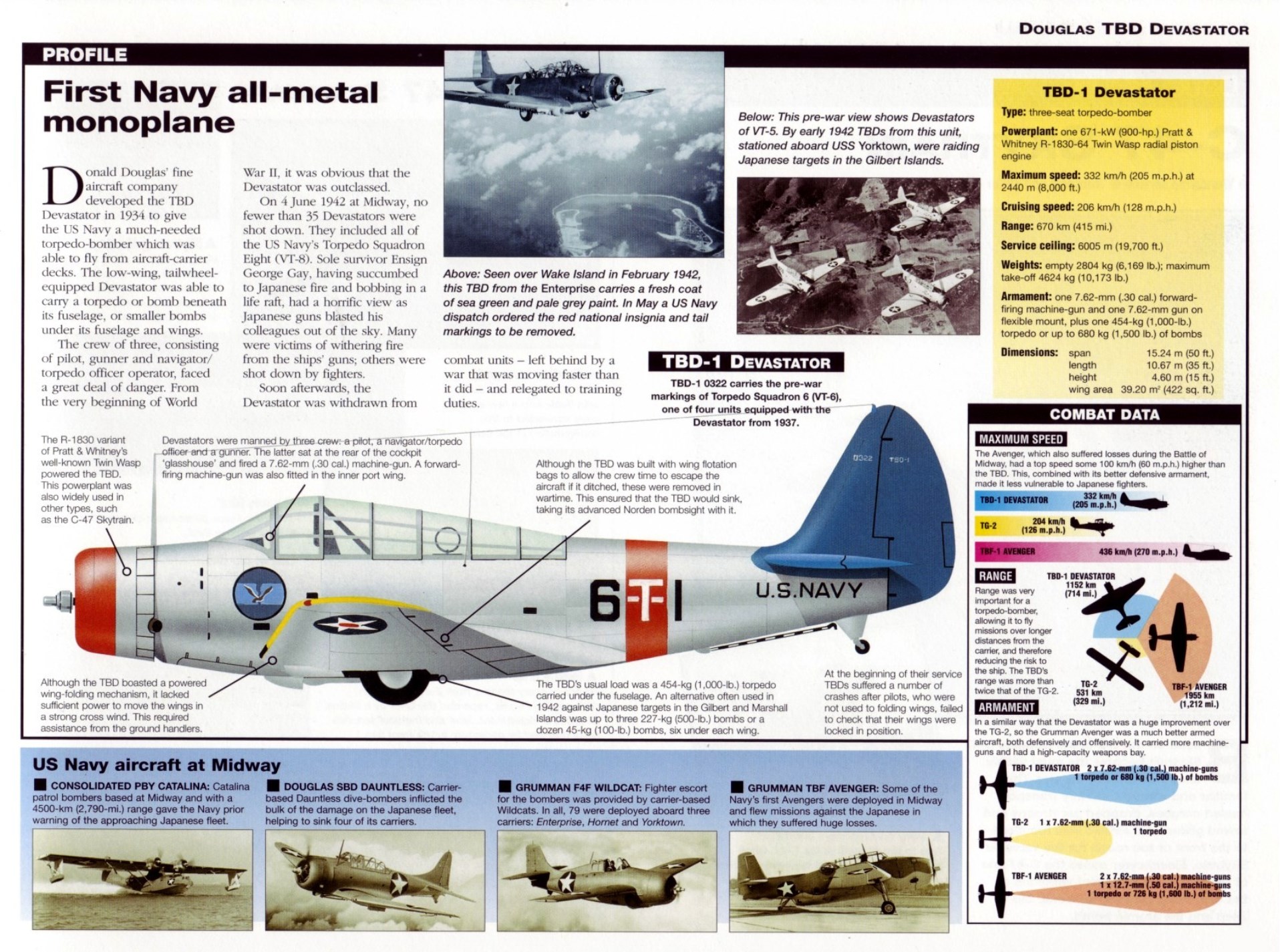
Reputation II
Torpedo-bomber development for carrier deployment in the
United States Navy generally followed a similar pattern as in other fleets,
although a small number of very large Douglas T2D twin-engine aircraft briefly
operated from the Langley in 1927 before they were fitted with floats and
redesignated patrol types to avoid political conflict with the Army Air Corps.
American carriers used essentially a single design from 1925 until 1937. The
initial version, the Martin T3M-2, was a three-seater biplane powered by a
770-horsepower Packard 3A-2500 water-cooled engine that gave it a maximum speed
of 109 miles per hour and a range of 630 miles. Subsequent versions, introduced
from 1928, used radial engines, either the 525-horsepower Pratt & Whitney
Hornet or the 620-horsepower Wright Cyclone, which gave the final version, the
Great Lakes TG- 2, a maximum performance of 127 miles per hour and a range of
330 miles. The Douglas TBD-1 re-equipped the fleet’s torpedo squadrons in 1937
and 1938, marking a great advance in capabilities. This all-metal low-wing
monoplane of stressed-skin construction also introduced flaps to aid slow-speed
handling, a retractable undercarriage, and power-operated wing folding. Powered
by a 900- horsepower Pratt & Whitney Twin Wasp radial engine driving a
variable- pitch propeller, the TBD-1 had a maximum speed of 206 miles per hour
and a range of 716 miles, both vastly superior to the performance of its precursors.
Eric Brown never found a British plane he didn’t like. I
don’t know a serious student of aviation that considers “Duels in the Sky” as
anything more than a curiosity. Perhaps reflecting his background Mr. Brown
seems to thing WWII aircraft were machines to have a joust in. They weren’t:
they were aircraft designed to kill enemy targets. If you use that simple
standard the Swordfish is a ridiculous choice for best torpedo plane of WWII.
One thing can hardly be stressed enough! The Swordfish never fought in a carrier
battle and thus almost never faced enemy fighters. I’m sure that Kate or
Avenger pilots wished they could say the same. (The Avenger was in service
nearly a full year before the Hellcat – it first saw important service at
Midway.)
The Swordfish was better than nothing and was lucky to
operate in an environment when radar and proper anti-aircraft were in their
infancy. In a Pacific carrier battle, I can’t see why Swordfish, with speed
that was as bad as the Devastator, would have had anything like the performance
to gain and maintain the proper angle of attack before being savaged by
fighters. (A carrier traveling at full bore could hit 30 knots: if your
aircraft tops out at less than 150mph, it should be obvious that unless an
approach was made perfectly, it would be agonizingly long and give defenders
excellent chances.) When some Swordfish tried to interfere with the Channel
Dash by Gneisenau and Scharnhorst they were obliterated by German fighters. I
shudder to think of what Zeros would have done with a place so slow and so
badly protected. (Even the Devastator was tougher than the Swordfish. Avengers
were hard planes to down for fighters.)
In addition, after 1942 Avengers became increasingly an all-purpose
bomber deemed strong enough to undertake sustained operations against land
targets. I cannot imagine a 140 mph aircraft doing that job in 1944. Avenger
pilots began to favor “glide bombing” against smaller ships to
torpedo attack and compiled a long list of kills in this mode – the attack on Truk
being the most spectacular. When Avengers targeted larger vessels the torpedo
was back and was primarily responsible for the death of Musashi and Yamato
among many others. OK, the Swordfish was useful against U-boats. So were lots
of planes: any plane was useful against U-boats. And I’d be surprised if many
subs sunk by Swordfish were torpedoed: bombs would have been a much more likely
weapon. Lastly, if the Swordfish was the best aircraft of its type in the war,
why on earth did the RN get rid of them as soon as Lend Lease Avengers became
available?
In combat, the Devastator proved itself a better weapon than
conventional wisdom allows. The type suffered no in-flight losses to enemy
action until the morning of 4 June 1942, six months after the Pacific War
erupted. The US naval establishment committed its TorpRons to war with a
marginal weapon – the Mk 13 torpedo – but the failings of that design were in
no way the fault of the TBD or Douglas Aircraft. In large part the successful
employment of VT-2, -3, -5, and -6 was due to the unusual depth of knowledge
and experience in those squadrons. Many pilots and aircrewmen had served for as
long as four years with their units before seeing combat, and that institutional
advantage made itself known in the far reaches of the vast Pacific Ocean during
the first half of 1942.
Variants
XTBD-1
Prototype powered
by a 800 hp (600 kW) XR-1830-60, one built.
TBD-1
Production variant
powered by a 850 hp (630 kW) R-1830-64, 129 built.
TBD-1A
One TBD-1 modified
with twin floats.
Douglas TBD Devastator
Crew: Three; pilot, torpedo officer/navigator, radioman/gunner
Length: 35ft (10.67m)
Wingspan: 50ft (15.24m)
Height: 15ft 1in (4.6m)
Empty weight: 5,600lb (2,540kg)
Loaded weight: 9,289lb (4,213kg)
Powerplant: Pratt & Whitney R-1830-64
Twin Wasp radial of 900hp
Top speed: 206mph at 8,000ft
Service ceiling: 19,500ft (5,945m)
Armament: 1× forward-firing 0.30in (7.62mm) or 0.50in (12.7mm)
machine gun,
1× 0.30in (7.62mm) machine gun in rear cockpit (later
increased to two)
Ordnance: 1× Mark 13 torpedo or 1× 1,000lb (454kg) bomb or
2× 500lb (227kg) bombs or 12× 100lb (45kg) bombs